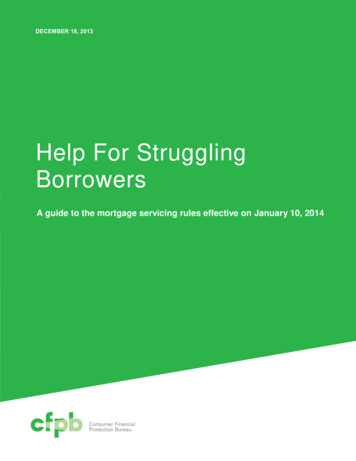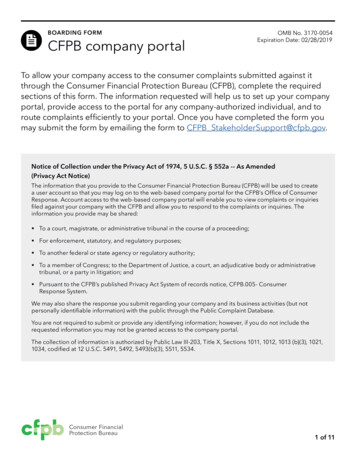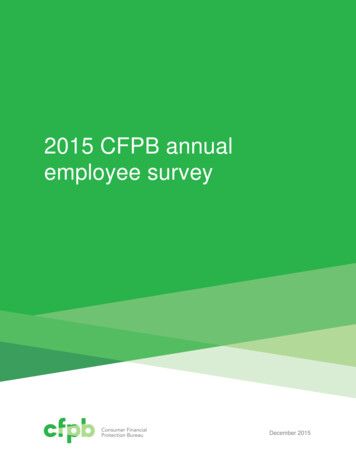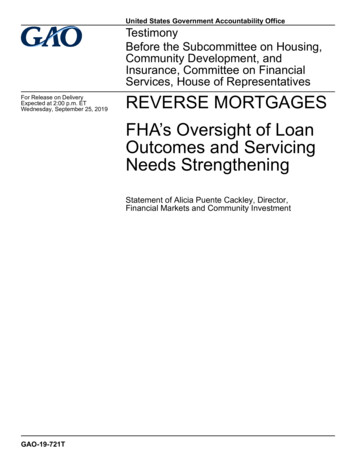
Transcription
DECEMBER 18, 2013Help For StrugglingBorrowersA guide to the mortgage servicing rules effective on January 10, 2014
Table of contentsIntroduction . 71. Applying for loss mitigation . 101.1Introduction . 101.2 Loss mitigation: General requirements on servicers. 121.3 Identifying key dates for loss mitigation and foreclosure . 121.4 When is a borrower delinquent? . 141.5 The loss mitigation process . 151.5.1Step one – The loss mitigation process: Live contactfrom the servicer to the borrower . 151.5.2Step two – The loss mitigation process: Generalinformation about loan workout and modificationpossibilities. 171.5.3Step three – The loss mitigation process: Assigningpersonnel and written notice . 191.5.4Step four – The loss mitigation process: Periodicstatements with delinquency information . 241.5.5Step five – The borrower applies for loss mitigation .271.5.6Step six – The servicer acknowledges receipt of theapplication and/or helps the borrower complete theborrower’s application . 281.5.7Step seven – The borrower completes the loss mitigationapplication . 302CONSUMER FINANCIAL PROTECTION BUREAU FOOTER STYLE
1.5.8Step eight – The servicer evaluates the borrower’scomplete the loss mitigation application . 321.5.9Step nine – The servicer offers or denies a lossmitigation option to the borrower . 361.5.10 Step ten–Borrower’s acceptance or rejection of an offermade by the servicer . 381.5.11 Borrower’s appeal rights if loss mitigation is denied . 411.6 Offers of loss mitigation where the borrower has not applied for lossmitigation or where the borrower has submitted an incomplete lossmitigation application but the offer is not based on this incompleteapplication . 421.7 The servicer’s obligation to comply with the loss mitigation rules if theborrower has sent a cease communication writing to the servicer . 431.8 Liability for failure to comply with 12 C.F.R. 1024.41 . 442. Foreclosure prohibitions . 452.1 Introduction . 452.1.1General . 452.1.2What does it mean to “file” a foreclosure . 462.2 When is a servicer prohibited from filing a foreclosure action? .472.3 What happens if the borrower submits a complete loss mitigationapplication after foreclosure has been filed? . 502.3.1More than 37 days before a foreclosure sale . 502.3.237 days or less before a foreclosure sale . 523. Charges and fees that can be imposed on a borrower . 533.1 Rules regarding processing and applying payments .533.1.1Full periodic mortgage payments . 533.1.2Partial periodic mortgage payments .553.2 Limitations on pyramiding late fees . 563.3 Limitations on force-placed insurance . 563CONSUMER FINANCIAL PROTECTION BUREAU FOOTER STYLE
3.3.1What is Force-placed Insurance? . 573.3.2When can the servicer purchase and charge the borrowerfor force-placed insurance? . 573.3.3How can the borrower prove that the borrower hashazard insurance coverage in order to avoid force-placedinsurance? . 593.3.4Purchasing and charging the borrower for force-placedinsurance . 604.3.3.5Force-placed insurance renewals and replacements .673.3.6Cancelling force-placed insurance . 71The error resolution process . 724.1 Step one –Written notice from borrower .724.1.1Notice content .724.1.2What is an error?.734.1.3What counts as a written notice? .764.1.4Where should the borrower send the written notice? .764.2 Step two – The servicer acknowledges receipt of the notice of error . 784.3 Step three – The servicer investigates the notice of error and respondsto the notice of error .794.3.1Investigation .794.3.2Response . 804.3.3Timing . 824.3.4Responding to multiple allegations of error . 834.3.5Exceptions . 834.4 Intersection of the error resolution rules and other laws. 845. Requests for information . 865.1 Step one: Written request for information from borrower . 8645.1.1Request content . 865.1.2What counts as a request for information? . 89CONSUMER FINANCIAL PROTECTION BUREAU FOOTER STYLE
5.1.3Where should the borrower send the written notice? . 905.2 Step two: The servicer acknowledges receipt of the request forinformation . 915.2.1Requirements . 915.2.2Exceptions . 925.3 Step three: The servicer responds to the information request . 935.3.1Response . 935.3.2Timing . 945.3.3Exceptions . 955.4 Other information request requirements . 955.4.1Fee for information . 955.4.2Intersection of the information request rules and otherlaws . 965.5 Information available on the Periodic Statement . 966. Requests for payoff statements. 986.1 Step one: . 986.2 Step two: . 986.2.1Accuracy . 986.2.2Timing . 99Appendix A: . 100Appendix B: . 1035CONSUMER FINANCIAL PROTECTION BUREAU FOOTER STYLE
This guide summarizes certain mortgage rules finalized by theCFPB in 2013, but it is not a substitute for the rules. Only the rulesand their official interpretations can provide complete anddefinitive information regarding their requirements.6CONSUMER FINANCIAL PROTECTION BUREAU FOOTER STYLE
IntroductionIn January 2013, the Consumer Financial Protection Bureau issued several final rulesconcerning mortgage markets in the United States (2013 Title XIV Final Rules), pursuant to theDodd-Frank Wall Street Reform and Consumer Protection Act (Dodd-Frank Act), Public LawNo. 111-203, 124 Stat. 1376 (2010).1 The Bureau issued various amendments to these rules thatare available on the Bureau’s website at glance/. This guide is concerned primarily with the new mortgage servicing rules, which aremeant to address consumer harm that took place in the mortgage servicing market.2The rules contain specific requirements, discussed in this guide. The rules also require servicersto adopt policies and procedures reasonably designed to achieve objectives relating to, among1Specifically, on January 10, 2013, the Bureau issued Escrow Requirements Under the Truth in Lending Act(Regulation Z), 78 FR 4726 (Jan. 22, 2013) (2013 Escrows Final Rule), High-Cost Mortgage and HomeownershipCounseling Amendments to the Truth in Lending Act (Regulation Z) and Homeownership Counseling Amendmentsto the Real Estate Settlement Procedures Act (Regulation X), 78 FR 6856 (Jan. 31, 2013) (2013 HOEPA Final Rule),and Ability-to-Repay and Qualified Mortgage Standards Under the Truth in Lending Act (Regulation Z), 78 FR 6407(Jan. 30, 2013) (2013 ATR Final Rule). The Bureau concurrently issued a proposal to amend the 2013 ATR Final Rule,which was finalized on May 29, 2013. See 78 FR 6621 (Jan. 30, 2013) and 78 FR 35430 (June 12, 2013). On January17, 2013, the Bureau issued the Real Estate Settlement Procedures Act (Regulation X) and Truth in Lending Act(Regulation Z) Mortgage Servicing Final Rules, 78 FR 10901 (Regulation Z) (Feb. 14, 2013) and 78 FR 10695(Regulation X) (Feb. 14, 2013) (2013 Mortgage Servicing Final Rules). On January 18, 2013, the Bureau issued theDisclosure and Delivery Requirements for Copies of Appraisals and Other Written Valuations Under the Equal CreditOpportunity Act (Regulation B), 78 FR 7215 (Jan. 31, 2013) (2013 ECOA Final Rule) and, jointly with other agencies,issued Appraisals for Higher-Priced Mortgage Loans, 78 FR 10367 (Feb. 13, 2013). On January 20, 2013, the Bureauissued the Loan Originator Compensation Requirements under the Truth in Lending Act (Regulation Z), 78 FR 11280(Feb. 15, 2013) (2013 Loan Originator Compensation Final Rule).2Bureau of Consumer Financial Protection, Mortgage Servicing Rules under the Real Estate Settlement ProceduresAct (Regulation X), 78 Fed. Reg. 10696, 10700 (February 14, 2013).7CONSUMER FINANCIAL PROTECTION BUREAU FOOTER STYLE
other things: accessing and providing timely and accurate information,3 properly evaluatingloss mitigation applications,4 facilitating oversight of and ensuring compliance with the rules byservice providers,5 facilitating transfer of information when servicing is transferred to a differentservicer,6 and informing borrowers of error resolution and information request procedures.78The rules also set forth requirements on record retention and the contents of a servicing file. Acopy of the rule, setting forth the specific items that must be covered in the servicer’s policiesand procedures, is attached to this outline as Appendix A.9These new rules become effective on January 10, 2014. Any borrower who is more than 37 daysfrom a foreclosure sale on January 10, 2014 and files a complete loss mitigation applicationbefore 37 days before a foreclosure sale is entitled to an evaluation of the complete lossmitigation application for all available loss mitigation options under 12 C.F.R. 1024.41, asdescribed more fully in section 1.5 of this guide.Small servicers are exempt from some of the new rules. A chart showing which servicers aresubject to which rules is attached to this Guide as Appendix B. A small servicer is either: A servicer that, together with affiliates, services 5,000 or fewer mortgage loans andservices only mortgage loans that they or an affiliate originated or own, or3456789812 C.F.R. § 1024.38(b)(1).12 C.F.R. § 1024.38(b)(2).12 C.F.R. § 1024.38(b)(3).12 C.F.R. § 1024.38(b)(4).12 C.F.R. § 1024.38(b)(5).12 C.F.R. § 1024.38(c).12 C.F.R. § 1024.38.CONSUMER FINANCIAL PROTECTION BUREAU FOOTER STYLE
A servicer that is a housing finance agency as defined in 24 C.F.R. 266.5.10This guide will aid in determining when a borrower is delinquent for purposes of Regulation X’searly intervention requirement, sets forth a step-by-step guide to the loss mitigation processunder the new servicing rules, and discusses when a servicer can initiate a foreclosure under thenew rules. The guide also discusses how to resolve servicer errors and how to requestinformation from a servicer.This guide is divided into six parts, as follows:1. The loss mitigation application process;2. Foreclosure prohibitions under the rule;3. Charges and fees that can be imposed on a borrower4. The process for resolving errors by a servicer;5. The process for requesting information from a servicer; and6. Requests for payoff statements10912 C.F.R. § 1026.41(e)(4).CONSUMER FINANCIAL PROTECTION BUREAU FOOTER STYLE
1. Applying for loss mitigation1.1IntroductionThis section sets out the early intervention, continuity of contact, and loss mitigation procedurescontained in the new rules, as well as periodic statement requirements for borrowers who aredelinquent on their mortgage. Borrowers should be encouraged to take full advantage of thecontacts and processes provided for in these rule. While some of these rules apply only todelinquent borrowers, a borrower can apply for loss mitigation relief whether or not theborrower is delinquent.The Federal regulations discussed here are meant to be minimum requirements for servicers,and states may adopt regulations that offer greater consumer protection.11 Individual mortgagelenders and owners are also free to adopt additional requirements for servicers.The rules provide that “A servicer is only required to comply with the requirements [in the lossmitigation procedures – 12 C.F.R. 1024.41] for a single complete loss mitigation application for aborrower’s mortgage loan account.”12This means that if a borrower submits a complete loss mitigation application, and later seeksadditional loss mitigation assistance, the borrower may not be entitled to a second full lossmitigation process under the rules.11Consumer Financial Protection Bureau, 2013 Real Estate Settlement Procedures Act (Regulation X) andTruth in Lending Act (Regulation Z) Mortgage Servicing Final Rules, Small Entity Compliance Guide at 11(November 27, 2013); 12 C.F.R. 1024.5(c) and Comment 5(c)(1)-1.121012 C.F.R. § 1024.41(i).CONSUMER FINANCIAL PROTECTION BUREAU FOOTER STYLE
However, if servicing on the account is transferred to a new servicer, the borrower may be ableto apply for loss mitigation again.13Documents and information transferred from the old servicer to the new servicer may count as an application for loss mitigation, triggering all of the responsibilities ofsection 1024.41.Small servicers do not have to comply with the loss mitigation rules, except that small servicersmust comply with the requirements in 24 C.F.R. 1024.41(f)(1)(prohibition on foreclosurereferral, including the 120-day limit)14 and cannot “make the first notice or filing required byapplicable law for any judicial or non-judicial foreclosure process and shall not move forforeclosure judgment or order of sale or conduct a foreclosure sale if a borrower is performingpursuant to the terms of an agreement on a loss mitigation option.”15If a servicer maintains an exclusive address that the borrower must use to assert an error againstthe servicer, or request information from the servicer, the servicer must include this exclusiveaddress in any written communications with the borrower required by 12 C.F.R. 1024.39 and 12C.F.R. 1024.41 in which the servicer gives the borrower the servicer’s contact information for16assistance.1312 C.F.R. part 1024 Supplement I, Comment 41(i) – 1 (“A transferee servicer is required to comply withthe requirements of § 1024.41 regardless of whether a borrower received an evaluation of a complete lossmitigation application from a transferor servicer.”).1412 C.F.R. § 1024.41(j); 12 C.F.R. § 1024.41(f)(1).1512 C.F.R. § 1024.41(j); Mortgage Servicing Rules: Coverage, available at http://files.consumerfinance.gov/f/201306 cfpb comparison-chart lation-z.pdf ;161112 C.F.R. part 1024 supplement 1, Comments 35(c) – 2(iv) and 36(b) – 2(iv).CONSUMER FINANCIAL PROTECTION BUREAU FOOTER STYLE
1.2Loss mitigation: General requirementson servicersThe new rules set forth the process that must be followed by a servicer who offers loss mitigationoptions to borrowers. The owner or assignee of a loan determines what options will be available.A servicer has no duty “to provide any borrower with any specific loss mitigation options.”17“Nothing in section 1024.41 [the loss mitigation section] should be construed to create a rightfor a borrower to enforce the terms of any agreement between a servicer and the owner orassignee of a mortgage loan, including with respect to the evaluation for, or offer of, any lossmitigation option or to eliminate any such right that may exists pursuant to applicable law.” 18The loss mitigation application rules only apply to loss mitigation applications submitted on orafter January 10, 2014.A borrower does not have to be delinquent to apply for loss mitigation.1.3Identifying key dates for loss mitigationand foreclosureSeveral key dates have to be identified, because the timing on various parts of the modificationand foreclosure process is tied to these dates. Some of the timing is based on how many days itis AFTER the borrower becomes delinquent. Other timing requirements are based on thescheduled date of a foreclosure sale, and how many days BEFORE that date a loss mitigationapplication is submitted. These crucial dates are:1712 C.F.R. § 1024.41(a).1812 C.F.R. § 1024.41(a).12CONSUMER FINANCIAL PROTECTION BUREAU FOOTER STYLE
The date of delinquency19 36 days after the date of the missed or partial payment 45 days after the date of the missed or partial payment 120 days after a borrower becomes delinquent The scheduled date of the foreclosure sale If no foreclosure sale is set at the time the borrower submits a complete lossmitigation application, the loss mitigation application is treated as if it wasreceived by the servicer more than 90 days before any foreclosure sale.20 Thistreatment remains true even if a foreclosure sale is later actually scheduled orre-scheduled.21 37 days before any scheduled foreclosure sale 45 days before any scheduled foreclosure sale 90 days before any scheduled foreclosure sale The date the servicer received a completed loss mitigation application, or the date aloss mitigation application is facially complete. The date the servicer provided the borrower with a loss mitigation offer.While there is no deadline for completing a loss mitigation application, the sooner the lossmitigation application is completed the more rights and time the borrower may have in the loss19Keep in mind that that the rule does not explicitly define “delinquency,” although the commentary doesexplain what constitutes a delinquency for certain specific purposes. See section 1.4 of this guide.2012 C.F.R. § 1024.41(b)(3) and Comment 41(b)(3) – 1.2112 C.F.R. part 1024 Supplement I, Comment 41(b)(3) – 2.13CONSUMER FINANCIAL PROTECTION BUREAU FOOTER STYLE
mitigation process. Borrowers who submit a completed application 37 days or less before aforeclosure sale are not entitled to have the servicer comply with the loss mitigation22requirements contained in 12 C.F.R. 1024.41 with respect to that application, although theservicer will still have to comply with any investor guidelines for loss mitigation applicationsreceived during this period.1.4When is a borrower delinquent?The rules do not provide an explicit definition of “delinquency,” but the commentary doesexplain what constitutes a delinquency for two specific purposes. If a borrower becomesdelinquent, a servicer has certain obligations to attempt contact with the borrower and assignpersonnel to be continually available to discuss the borrower’s loan. A borrower is delinquentfor purposes of these early intervention (12 C.F.R. 1024.39) and continuity of contact (12 C.F.R.1024.40) requirements when the borrower fails to make a payment sufficient to cover principal,interest and, if applicable, escrow on the date that the payment is due.23A borrower is delinquent on the day a full payment is due and not fully paid, “even if theborrower is afforded a period after the due date to pay before the servicer assesses a late fee.” 24For example, 12 C.F.R. 1024.39 provides that a servicer must “establish or make goodfaith efforts to establish live contact with a delinquent borrower not later than the 36thday of the borrower’s delinquency ”25 This means that if the borrower’s payment wasdue on January 1 “and the amount due is not fully paid during the 36-day period afterJanuary 1, the servicer must establish or make good faith efforts to establish live contact2212 C.F.R. part 1024 Supplement I, Comment 41(g) – 4.2312 C.F.R. part 1024 Supplement I, Comments 39(a) – 1(i); 39(b)(1) – 1 and 40(a) – 3.2412 C.F.R. part 1024 Supplement I, Comment 39(a) – 1(i).2512 C.F.R. § 1024.39(a).14CONSUMER FINANCIAL PROTECTION BUREAU FOOTER STYLE
not later than 36 days after January 1 – i.e., by February 6.”26 This means that January 2is day one, January 3 is day 2, etc.1.5The loss mitigation process1.5.1Step one – The loss mitigation process: Live contactfrom the servicer to the borrowerREQUIREMENTBetween the day the borrower’s mortgage payment is due and not paid in full and 36 days laterthe servicer must make a good faith effort to reach the borrower, or an authorized agent of theborrower, by telephone (not just leave a message) or talk to the borrower in an in-personmeeting to discuss the circumstances of the borrower’s delinquency. 27Servicers are encouraged to reach out more than once to a delinquent borrower toestablish live contact, so a borrower should not be surprised to receive more than onephone call or electronic communication from the servicer if the borrower has notresponded to the servicer’s efforts to reach the borrower.28EXCEPTIONSThis rule does not require contact with a borrower who: 26has filed for bankruptcy relief or whose joint obligor has filed for bankruptcy relief;2912 C.F.R. part 1024 Supplement I, Comment 39(a) – 1(i).2712 C.F.R. § 1024.39(a) and Comment 39(a) – 2. Contacting an agent is permitted by 12 C.F.R. part 1024Supplement I, Comment 39(a) - 4.28Id.2912 C.F.R. § 1024.39(d)(1) and Comment 39(d)(1) – 3.15CONSUMER FINANCIAL PROTECTION BUREAU FOOTER STYLE
has instructed the servicer in writing to cease communications with the borrowerpursuant to the Fair Debt Collection Practices Act, if the servicer is a debt collector30subject to the Fair Debt Collection Practices Act with respect to that borrower; is making payments as agreed on any loss mitigation contract; 31 sent a timely payment to a former servicer within 60 days before the current servicertook over the loan, and if the current servicer learns of this payment and documentsthe misdirected payment in the servicer’s files; 32 cures a delinquent payment during this 36-day initial contact period.333012 C.F.R. § 1024.39(d)(2). The FDCPA cease communications rule can be found at 15 U.S.C. § 1692c(c).3112 C.F.R. part 1024 Supplement I, Comment 39(a) – 1(ii).3212 C.F.R. part 1024 Supplement I, Comment 39(a) – 1(iii).3312 C.F.R. part 1024 Supplement I, Comment 39(a) – 1(iv).16CONSUMER FINANCIAL PROTECTION BUREAU FOOTER STYLE
1.5.2Step two – The loss mitigation process: Generalinformation about loan workout and modificationpossibilitiesREQUIREMENTWhat and When?Promptly after the servicer makes live contact with the borrower the servicer must tell theborrower, or an authorized agent of the borrower, about the availability of loss mitigationoptions if appropriate.34 It is within the servicer’s “reasonable discretion” to decide if it is appropriate under the35circumstances to inform the borrower about the availability of loss mitigation options.The commentary to the rule gives examples: If a borrower has had a “material adverse change in the borrower’s financialcircumstances that is likely to cause the borrower to experience a long-termdelinquency for which loss mitigation options might be available,” the servicershould tell the borrower about those options.36 If the borrower says simply that a payment will be late, the servicer does nothave to inform the borrower about the availability of loss mitigation options. 37 The information given to the borrower at this stage does not have to be about specificworkout options. Rather, the servicer can just tell the borrower “generally that lossmitigation options may be available.” 383412 C.F.R. § 1024.39(a); contacting an agent is permitted by 12 C.F.R. part 1024 Supplement I, Comment39(a) – 4.3512 C.F.R. part 1024 Supplement I, Comment 39(a) – 3.3612 C.F.R. part 1024 Supplement I, Comment 39(a) – 3(i)(A).3712 C.F.R. part 1024 Supplement I, Comment 39(a) – 3(i)(B).17CONSUMER FINANCIAL PROTECTION BUREAU FOOTER STYLE
How Given? The servicer can give the borrower the information about loss mitigation options “orally,in writing, or through electronic communication.”39 The servicer can comply with this obligation by giving the written notice required by 12C.F.R. 1024.39(b) (discussed in section 1.5.3) to the borrower promptly after establishinglive contact.40EXCEPTIONSThis early intervention rule does not require contact with a borrower who: has filed for bankruptcy relief or whose joint obligor has filed for bankruptcy relief; has instructed the servicer in writing to cease communications with the borrower41pursuant to the Fair Debt Collection Practices Act, if the servicer is a debt collector42subject to the Fair Debt Collection Practices Act with respect to that borrower;43 is making payments as agreed on any loss mitigation contract; sent a timely payment to a former servicer within 60 days before the current servicertook over the loan, and if the current servicer learns of this payment and documents themisdirected payment in the servicer’s files.443812 C.F.R. part 1024 Supplement I, Comment 39(a) – 3(ii).3912 C.F.R. part 1024 Supplement I, Comment 39(a) – 3(ii).4012 C.F.R. part 1024 Supplement I, Comment 39(a) – 3(ii).4112 C.F.R. § 1024.39(d)(1) and Comment 39(d)(1) – 3.4212 C.F.R. § 1024.39(d)(2). The FDCPA cease communications rule can be found at 15 U.S.C. § 1692c(c).4312 C.F.R. part 1024 Supplement I, Comment 39(a) – 1(ii).4412 C.F.R. part 1024 Supplement I, Comment 39(a) – 1(iii).18CONSUMER FINANCIAL PROTECTION BUREAU FOOTER STYLE
1.5.3Step three – The loss mitigation process: Assigningpersonnel and written noticeBetween the day of the borrower’s missed mortgage payment and 45 days later the servicershould assign personnel to the mortgage, and must send a written notice.ASSIGNING PERSONNELRequirementIn order to provide continuity of contact, the servicer should45 assign personnel (which can beone or more persons)46 to the delinquent borrower, or an authorized agent of the borrower,47who will be available via telephone, immediately or in a “timely manner”. 48 The servicer must “maintain policies and procedures that are reasonably designed toensure that” the servicer can: provide the assigned personnel with access to all documents and information the49borrower submits in connection with a loss mitigation option; and facilitate the sharing of accurate and current information about the borrower’sloss mitigation application and the status of any foreclosure proceeding betweenthe assigned personnel and other appropriate personnel, such as those handlinga foreclosure.504512 C.F.R. § 1024.38(a)( the servicer shall “maintain policies and procedures reasona
The guide also discusses how to resolve servicer errors and how to request information from a servicer. This guide is divided into six parts, as follows: 1. The loss mitigation application process; 2. Foreclosure prohibitions under the rule; 3. Charges and fees that can be imposed on a borrower 4. The process for resolving errors by a servicer; 5.










